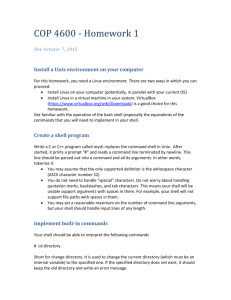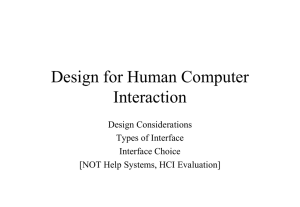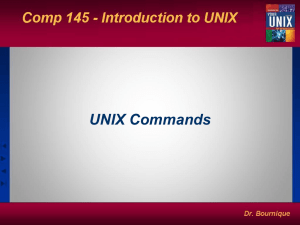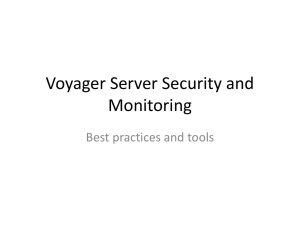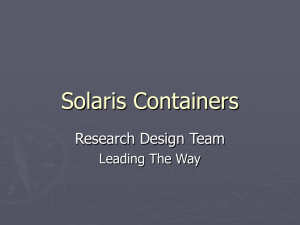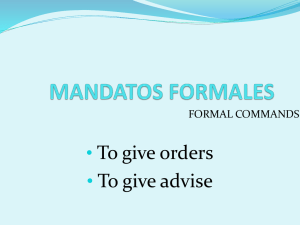SO111 - Introduction to the Solaris 10 Operating Environment
advertisement
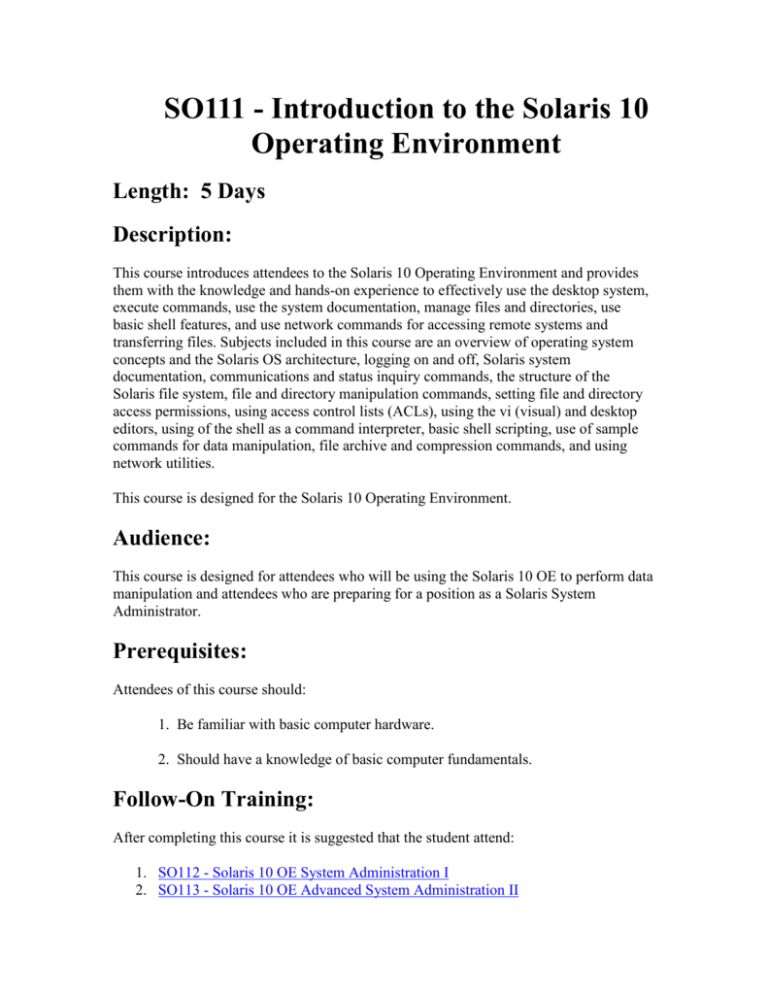
SO111 - Introduction to the Solaris 10 Operating Environment Length: 5 Days Description: This course introduces attendees to the Solaris 10 Operating Environment and provides them with the knowledge and hands-on experience to effectively use the desktop system, execute commands, use the system documentation, manage files and directories, use basic shell features, and use network commands for accessing remote systems and transferring files. Subjects included in this course are an overview of operating system concepts and the Solaris OS architecture, logging on and off, Solaris system documentation, communications and status inquiry commands, the structure of the Solaris file system, file and directory manipulation commands, setting file and directory access permissions, using access control lists (ACLs), using the vi (visual) and desktop editors, using of the shell as a command interpreter, basic shell scripting, use of sample commands for data manipulation, file archive and compression commands, and using network utilities. This course is designed for the Solaris 10 Operating Environment. Audience: This course is designed for attendees who will be using the Solaris 10 OE to perform data manipulation and attendees who are preparing for a position as a Solaris System Administrator. Prerequisites: Attendees of this course should: 1. Be familiar with basic computer hardware. 2. Should have a knowledge of basic computer fundamentals. Follow-On Training: After completing this course it is suggested that the student attend: 1. SO112 - Solaris 10 OE System Administration I 2. SO113 - Solaris 10 OE Advanced System Administration II 3. SO114 - Solaris 10 OE Network Administration Course Materials: 1. SO111 - Introduction to the Solaris 10 Operating Environment Student Guide Course Objectives: Upon completion of this course the attendee will be able to: state the major components and architecture of Solaris; log on and off of Solaris; use the Solaris system documentation; enter and execute simple commands, commands with options, and commands with arguments; organize and manipulate files and directories and their contents; modify file and directory access permissions and access control lists (ACLs); use the vi and desktop editors to create and modify files; use the Solaris shell file name expansion, I/O redirection, pipe, and quoting mechanisms; read simple shell scripts; use selected Solaris utilities to manipulate file contents; use file compression utilities; create archive and extract files from archives; and, use network commands to access remote systems and transfer files. Course Content: Unit 1 - Solaris Operating Environment Overview 1. 2. 3. 4. 5. 6. 7. Operating System Overview Operating System Development What is UNIX? What is Solaris? UNIX Development History Unix Features Unix Architecture Unit 2 - Using Solaris 1. Logging In 1. Command Line Login 2. Desktop Login 2. Using the Desktop Environment 1. The Taskbar 2. The Workspace Menu 3. Starting A Terminal Window 3. Logging Off 4. Using the Command Line 1. The Shell 2. Keyboard Usage 3. Shell Prompts 5. Solaris Documentation 6. Solaris Reference Manual 1. Example Man Page 2. The man Command 3. Keyword Searches - The apropos Command 4. Keyword Searches - The whatis Command 7. Executing Commands 1. Simple Commands 2. Commands with Options 3. Commands with Arguments 8. Changing Your Password 9. User and Group ID 10. Checking Processes 11. Checking System Processes Unit 3 - The Solaris Filesystem 1. 2. 3. 4. 5. 6. 7. Types of Files Filesystems File and Directory Naming Filesystem Organization Pathnames Listing Files and Directories File and Directory Attributes 1. File and Directory Access Permissions 2. Changing File Access Permissions 8. Moving Around the Filesystem 9. Directory Commands 10. File Manipulation Commands 11. The umask Command 12. Changing File Ownership 13. Changing File Group Ownership 14. Changing File Timestamps 15. Displaying and Printing Files 16. Access Control Lists 17. Printing Files Unit 4 - Solaris Text Editing 1. Types of Editors 2. Editing Concepts 3. Getting Started with vi 4. Editing Modes 5. Saving Text and Exiting vi 6. Moving Around in vi 7. Creating New Text 8. Line Substitutions 9. vi Shortcuts 10. Editor Options 11. The Desktop Editor Unit 5 - The Shell 1. Types of Shells 2. Shell Documentation 3. Shell Functions 4. The echo Command 5. Filename Generation 6. Shell Variables 7. Quoting 8. I/O Redirection 9. Pipes 10. Establishing the User Environment 11. Background Processing 12. Jobs 13. Command Line Editing 14. The nohup Command 15. Creating and Executing Simple Shell Scripts 1. Creating a Shell Program 2. Executing a Shell Program 3. Passing Arguments to a Shell Script 4. Using the test Command 5. Performing Conditional Tests Unit 6 - Solaris Utilities 1. 2. 3. 4. 5. 6. Regular Expressions File Manipulation Commands Other Useful Data Manipulation Commands File Information Commands File Comparison Commands File Archives 1. Creating Archives using tar and jar 2. Extracting Files from tar and jar Archives 7. Compressing and Uncompressing Files 8. Using the compress Command 1. Using the gzip Command 2. Using the zip Command Unit 7 - Network Commands 1. Connecting to a remote system using a terminal session 2. Transferring files between the local and remote system Appendix A - vi Editor Quick Reference Appendix B - Answers to Exercises Appendix C - Answers to Review Questions Disclaimer: The contents of this outline reflect the general subjects and topics covered in this course. The author continually updates courses as changes are made to the operating systems and/or applications. Therefore, the actual course may contain additional information, deleted subjects, or the order of presentation may be different. The author reserves the right to make changes to the course content without notification and the outline may not always reflect the exact course content.

